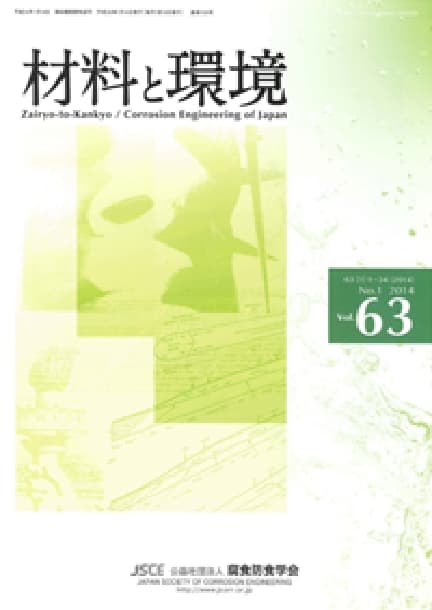材料と環境 Vol. 73 (2024), No. 10
Backnumber
-
Vol. 74 (2025)
-
Vol. 73 (2024)
-
Vol. 72 (2023)
-
Vol. 71 (2022)
-
Vol. 70 (2021)
-
Vol. 69 (2020)
-
Vol. 68 (2019)
-
Vol. 67 (2018)
-
Vol. 66 (2017)
-
Vol. 65 (2016)
-
Vol. 64 (2015)
-
Vol. 63 (2014)
-
Vol. 62 (2013)
-
Vol. 61 (2012)
-
Vol. 60 (2011)
-
Vol. 59 (2010)
-
Vol. 58 (2009)
-
Vol. 57 (2008)
-
Vol. 56 (2007)
-
Vol. 55 (2006)
-
Vol. 54 (2005)
-
Vol. 53 (2004)
-
Vol. 52 (2003)
-
Vol. 51 (2002)
-
Vol. 50 (2001)
-
Vol. 49 (2000)
-
Vol. 48 (1999)
-
Vol. 47 (1998)
-
Vol. 46 (1997)
-
Vol. 45 (1996)
-
Vol. 44 (1995)
-
Vol. 43 (1994)
-
Vol. 42 (1993)
-
Vol. 41 (1992)
-
Vol. 40 (1991)
キーワードランキング
13 Dec. (Last 30 Days)
材料と環境 Vol. 73 (2024), No. 10
Electrochemical Behavior of Mg-Mn Alloy in NaCl Solutions with Different Concentrations
Jian Tang, Muye Yang, Shigenobu Kainuma
pp. 230-233
DOI:
10.3323/jcorr.73.230抄録
This study investigated the impact of NaCl concentration on the electrochemical performance of one kind of commercial Mg-Mn alloy (M1C). Firstly, potentiodynamic polarization (PDP) tests were conducted to determine corrosion behavior of M1C in NaCl solutions with concentrations of 0.1 mass%, 0.5 mass%, 3.5 mass%, and 10.0 mass%. Additionally, electrochemical impedance spectroscopy (EIS) tests were performed to analyze the oxide film thickness across varying solution concentrations. The PDP results indicated that the corrosion rate of M1C increased with the increase of solution concentration. Furthermore, breakdown potential was observed in anodic polarization curves when the concentration of NaCl solution was over 0.5 mass %. The EIS results showed that after 24h immersion, thickness of MgO film decreased with increasing NaCl concentration and then stabilized.
NaCl水溶液中におけるWC-Ni-Cr-Mo系超硬合金の腐食挙動に及ぼすpHおよび電位の影響
伊藤 暢晃, 山本 涼太郎, 杉山 憲一, 八鍬 浩, 大井 梓, 多田 英司
pp. 234-243
DOI:
10.3323/jcorr.73.234抄録
The corrosion resistance of WC-Ni-Cr-Mo cemented carbides in aqueous NaCl solutions at various pH values has been investigated by electrochemical measurements, surface observation and solution analysis. In acidic environments, WC passivates and binder metals selectively dissolve. In neutral environments, Cr and Ni passivate at corrosion potential and lower potentials than 0.5 V and WC either passivate or dissolve at a slower rate, while transpassive dissolution of Cr in the binder and dissolution of W occurs at potentials higher than 0.5 V. In a basic environment, the dissolution behaviour of the WC-Ni-Cr-Mo alloy is similar to that in a neutral environment, however, the dissolution of WC occurs significantly with increasing anodic potential from corrosion potential.
論文アクセスランキング
13 Dec. (Last 30 Days)
-
大気腐食環境下における1700 MPa級調質ボルトの遅れ破壊機構
鉄と鋼 早期公開
-
Perspectives on the Promising Pathways to Zero Carbon Emissions in the Steel Industry toward 2050
ISIJ International Vol.65(2025), No.2
-
-
Factors Influencing the Bonding Phase Structure of Iron Ore Sinters
ISIJ International Vol.43(2003), No.9
-
-
-
Progress of Strip Casting Technology for Steel; Historical Developments
ISIJ International Vol.52(2012), No.12
-
Research Progress on Optimal Blending of Iron Ore Powders for Sintering
ISIJ International Vol.65(2025), No.12
-
-
Microstructures and Reduction Properties of High CaO Concentration Sintered Ore
ISIJ International 早期公開
この機能はログイン後に利用できます。
下のボタンをクリックしてください。










